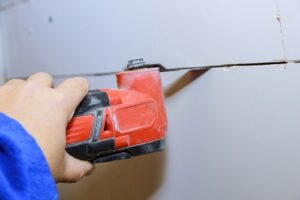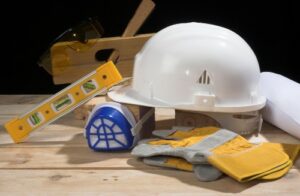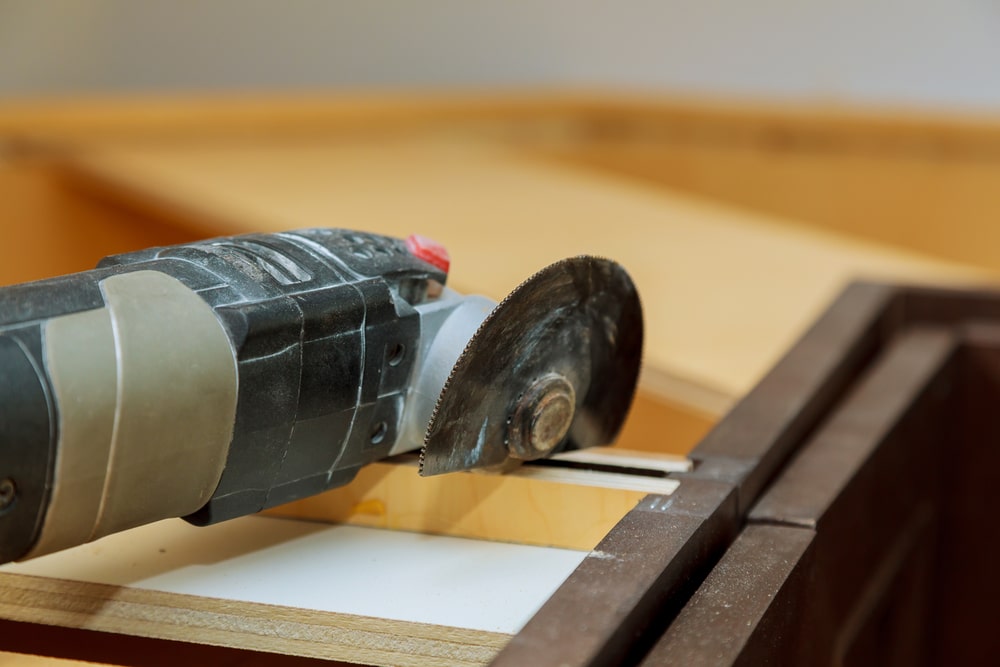Last Updated on January 10, 2023
Of all the power tools you can buy, an oscillating multi-tool is the most versatile. This handy power tool allows you to tackle multiple DIY projects. It can do anything from removing grout and sanding, to plunge cuts and removing old paint!
But how can you safely and effectively use a multi-tool? Due to the different attachments and ways you can use these tools, it can be overwhelming. Fear not! In this guide, we take a detailed look at how to use a multi tool and offer some excellent tips, too – enjoy!
A Brief Introduction to Multi-Tools
First, let’s go over what a multi-tool is and how it works. As the name suggests, an oscillating multi-tool can be used for multiple purposes. This is due to the different multi-tool attachments you can use with the oscillating head.
For example, you can use a sanding attachment, a reciprocating saw, a carbide blade, or a circular metal cutting disk. There is an endless variety of accessories you can use, hence the name!
In terms of power, the motor of an oscillating multi-tool generates oscillations or vibrations. This is measured as OPM or oscillations per minute. These vibrations are then used to power the different accessories and make them move back and forth incredibly fast. It is this combination of movement and vibrations that enable cutting, sanding, and scraping actions.
What Can I Do With a Multi Tool?
As you can see, an oscillating multi-tool has excellent potential. But what are the multi tool uses and how exactly can you use one? Saying it can have multiple attachments is still quite vague! To give a clear idea, we have listed some of the main ways you can use this type of power tool below:
- Grout removal from tiles
- Sanding of different materials like wood and metal
- Removing old adhesive from carpets and tiles
- Grinding mortar from bricks and breezeblocks
- Cutting materials to size like tiles, beams, and carpet sections
- Making a plunge cut in wood and decking
- Trimming protruding objects like pipes, bolts, and nails
Yes, an oscillating tool can do all of the above (providing you have the correct attachments of course). They are incredible tools and perfect for cutting, grinding, sanding, trimming, and removal. If you want to prepare an area ready for an installation, like new flooring, an oscillating tool is an essential item.
Also, for general DIY tasks and small jobs around the house and garden, this type of power tool will come in handy time and time again!
Using a Multi-Tool
So, how can you use a multi-tool safely? As with any power tool, there is always an element of danger involved. Also, there is inevitably a learning curve – even if you are experienced with power tools and DIY work.
To start, we always advise reading the included instruction manual fully. This should show you simple functions like how to turn the device on, and how to change the head accessories. Also, it may even include some useful tips for using the different accessories. Next, we have provided a basic guide on setup and preparation, and the main functions of an oscillating tool below:
Setup and Preparation
Before even attempting any tasks you must first set up your oscillating tool and prepare yourself. This involves first putting on any protective equipment for safety. It may seem like a chore to do this, but as stated, these tools can be dangerous!
If you are using a sanding pad, we advise wearing a dust mask. This will prevent breathing any shavings from the sanding and potentially damaging your lungs. Also, consider wearing protective safety glasses to prevent any shards from flying into your eyes.
Depending on how comfortable you are with power tools, you may also want to wear protective gloves. Some people forgo these, but we would always advocate wearing them to protect your hands, fingers, and wrists.
Once you are protected, you can make sure you have the correct attachment for your oscillating tool. Usually, you can release the tool blade head either via a switch, or a locking nut and Allen key. If you have read the instructions, you should easily be able to change the head. You will find it much easier if you practice changing the head and attaching things like the multi-tool blade beforehand.
Cutting / Sawing
One of the main functions of an oscillating tool is cutting and sawing. These tools usually come with a range of cutting blade attachments such as a metal cutting blade, a plunge cut blade, and a circular blade. First, select the right blade for the job and ensure it is secured to the head.
Depending on what you are cutting, and the level of neatness you require, you may also want to mark the cutting line with a pencil. For example, if you want to cut holes in drywall for a socket, or cut floorboards for new flooring – marking your cuts will offer a greater degree of accuracy.

Next, use the trigger or power switch to turn the oscillating tool on. You should then apply gentle pressure to the material and the cutting process will start. For plunge cuts, straight cuts, and flush cutting, you may want to use the depth gauge if the oscillating tool has one. This is a simple gauge you can set at the desired height that will help you keep the blade steady, and control the back and forth motion of the oscillating multi-tool, and get straight cuts.
Periodically, we advise blowing or clearing away the build-up of shavings surrounding the material as this can impede the cutting process and cause you to misalign your cutting strokes.
These tools are incredibly useful if you want to cut wood and you can comfortably use the wood blade to trim door casings, door jambs, and even match notch cuts.
Sanding
Aside from cutting, the oscillating multi-tool is also fantastic for sanding. Most multi-tools will have a sanding head and you can attach different types of sandpaper to it. Once you have attached the correct head, ensure that you have also secured the sandpaper properly. If you do not secure it, it could come loose and cause a potential safety hazard.
Next, we advise setting the speed of the oscillating multi-tool if it has a variable speed option. It is advisable to sand at a lower speed setting – if you use it at full power, you risk over-sanding the object.
Once you have set the speed, you can turn the device on and apply gentle pressure to the area. When sanding a large open area, use a circular motion and try to apply pressure evenly. Keep the tool moving to ensure you get an even sanding finish. For corners of drywall and wood, you may want to use a delta sanding head. This has a triangular shape that allows you to sand into smaller areas and 90-degree corners with ease.
Removing / Scraping
Finally, when using an oscillating tool, you can use the scraper blade attachment for “removing”. This can include the removal of old paint, grout removal, mortar removal, and adhesive removal.
As with the other attachments, ensure it is secure, and that you have chosen the correct accessory. When removing grout, for example, there may be a specialized head that is shaped like a screwdriver – this would be much more suitable than the scraper blade and would help you avoid damaging the tiles.
Once you have the head or blade attached, start the tool and push it forward at a slight angle and keep pressure applied. The saw blade will remove the unwanted materials in chunks. We advise stopping periodically to remove the broken material and clear your working area so you can check your progress easily. Also, check the angle to ensure that you are only removing the unwanted material, and not any of the solid surfaces beneath it.
Useful Tips for Using a Multi-Tool
You should now have a clear idea of how to use a multi tool and what you can do with it. These tools are perfect for a range of tasks and if you regularly undertake DIY jobs, the investment is definitely worth it.
To finish, we have listed some general tips relating to oscillating multi-tool usage below:
1. Always wear the correct protective gear.

We advocate the use of safety gear when using these tools. We appreciate that not everyone likes wearing safety gear – it is irritating and it can slow the process. However, is completing the job quicker more important than potentially losing a finger or even your sight?! We would hope not! Ideally, you should have protective gloves, goggles, and a dust mask if you are cutting or sanding.
2. Do not apply too much pressure.
A common mistake people make is to apply immense pressure when using a multi-tool. If you apply great pressure, you will reduce the longevity of the attachments. Also, you could risk damaging the tool and burning-out the motor.
By only applying minimal pressure when cutting or sanding, you can also control the motion easier and the end result will be far better.
3. Use the correct multi-tool blades for the right type of cut.
Multi-tools are fantastic for cutting. They also usually have a range of blades for different cutting work. It is important to research the different blades beforehand. Ensure you fully understand each blade, and what it is suitable for.
4. Use the correct blade type for different materials.
Different accessories are suitable for different material types. If you use the wrong type of saw blade, you could damage the material, and even damage the blade and tool. For example, a saw blade for plunge cuts is suitable for wood, but it may not be suitable for cutting tiles or cement. You may need a tougher circular blade or even a diamond-tipped blade to tackle tougher materials. Always check the instructions and contact the manufacturer if you are unsure.
5. Take care when cutting pipes.

A multi-tool with saw blade attachment is great for cutting pipes and tubing. You must always take care when cutting any type of pipe or tube. Ensure that you know fully what the pipe is, where it terminates, and what is inside. You do not want to cut an important electrical line, or damage an important pipe for the internal workings of a property!
6. When cutting, make several passes through the material.
When using an oscillating tool, the cutting process can be tricky. It can be difficult to cut wood and get a straight line or avoid splinters. A great tip is to make several passes through the material when cutting.
Many people make the mistake of cutting the entire way through in one motion – this can cause splintering and damage the underside of the material. On your first pass, cut partially through the material across the entire cut length. Repeat this process and each time get steadily deeper – this will create a much cleaner cut.
Multi-Tool FAQs
Can you use a multi-tool as a grinder?
Yes, providing that it has a circular saw attachment. With such an attachment you can grind old nails, bolts, and screws, and other metal pieces.
Is a multi-tool worth it?
Certainly! These versatile tools can save on the expense of purchasing multiple single tools. They can be handy for both home DIY and general construction work.
Can a multi-tool cut brick?
Yes! A multitool can cut through materials like brick, cement, and stone. However, it is not really suitable for tougher materials like rock, and concrete.
Does a multi-tool need a power cable?
Not necessarily. You can get both corded and cordless oscillating multi-tools. Cordless oscillating multi-tools offer greater freedom, but you must consider the charging time and battery life.
Final Thoughts
We hope this guide has been useful and you now know how to use a multi tool safely and effectively. If you take your time to practise using the tool before jumping in with big, important projects, we believe you will be a pro in no time.
Let us know how you get on.
Paul is the type of person who never met a problem he couldn’t fix. He can always be found tinkering with something in his house, even if it isn’t broken! His tips and tricks are often shared on our site. He’s the one you call when something breaks because he has been known to improvise fixes for everything from leaky faucets to malfunctioning dryers.

